Submitted:
01 April 2023
Posted:
04 April 2023
You are already at the latest version
Abstract
Keywords:
1. Introduction
2. Study Area
3. Materials and Methods
3.1. Remote Sensing Data
3.3. Methodology
3.3.1. Surface Urban Heat Island and its Surroundings Estimation
3.3.2. Urban and Surroundings areas selection
3.3.3. UTFVI and TDI indexes
4. Results and Discussion
4.1. Surface Urban Heat Island
4.1.1. Maximum and average urban heat island
4.3. Thermal Indexes
4.3.1. Urban Thermal Field Variation Index
4.3.2. Thermal Discomfort Index
4.5. Summary of Results
5. Conclusions/Concluding Remarks
Author Contributions
Funding
Acknowledgments
Conflicts of Interest
References
- Oliveira, A.; Lopes Oliveira, A.; Lopes, A.; Niza, S.; Soares, A. An Urban Energy Balance-Guided Machine Learning Approach for Synthetic Nocturnal Surface Urban Heat Island Prediction: A Heatwave Event in Naples. Sci. Total Environ. 2022, 805, 15013. [Google Scholar] [CrossRef] [PubMed]
- Bechtel, B.; Demuzere, M.; Mills, G.; Zhan, W.; Sismanidis, P.; Small, C.; Voogt, J. SUHI Analysis Using Local Climate Zones—A Comparison of 50 Cities. Urban Clim. 2019, 28, 100451. [Google Scholar] [CrossRef]
- F.R.;E.D.; F.P.; Clima Tempo, 1nd ed.; S.A.; Embrapa Informática Agropecuária: Campinas-SP, Brazil, 2008; Volume 1, pp. 17-19. E.D.; F.P.; Clima Tempo, 1nd ed.; S.A.; Embrapa Informática Agropecuária: Campinas-SP, Brazil.
- IPCC. IPCC sixth assessment report. Available online: https://www.ipcc.ch/report/ar6/wg2-communities (Accessed on 15 march 2023).
- Yang, J.; Wang, Y.; Xiu, C.; Xiao, X.; Xia, J.; Jin, C. Optimizing Local Climate Zones to Mitigate Urban Heat Island Effect in Human Settlements. J. Clean. Prod. 2020, 275, 123767. [Google Scholar] [CrossRef]
- Franco, F.M.; Nogueira. M.C.; Rosseti, K.A.; Nogueira, J.S. CLIMA URBANO: UM ESTUDO DE CASO PARA CLIMA TROPICAL CONTINENTAL. Climep, 2010, 5, 81–99. [Google Scholar]
- Gartland, L. Ilhas de calor: Como mitigar zonas de calor em áreas urbanas. 1nd ed.; Oficina de Textos. São Paulo, Brazil, 2011. 1 pp. 8.
- Del Serrone, G.; Peluso, P.; Moretti, L. Evaluation of Microclimate Benefits Due to Cool Pavements and Green Infraestrutures on Urban Heat Islands. Atmosphere 2022, 13, 1586. [Google Scholar] [CrossRef]
- Guimarães, J.T.F.; Sahoo, P.K.; e Souza-Filho, P.W.M.; da Silva, M.S. , Rodrigues T.M., da Silva E.F. Reis L.S., de Figueiredo M.M.J.C., Lopes K.d.S., Moraes A.M., Leite A.S., da Silva Júnior R.O., Salomão G.N., Dall’Agnol R. Landscape and Climate Changes in Southeastern Amazonia from Quaternary Records of Upland Lakes. Atmosphere 2023, 14, 621. [Google Scholar] [CrossRef]
- Budhiraja, B.; Gawuc, L.; Agrawal, G. Seasonality of Surface Urban Heat Island in Delhi City Region Measured by Local Climate Zones and Conventional Indicators. IEEE J. Sel. Top. Appl. Earth Obs. Remote Sens. 2019, 12, 5223–5232. [Google Scholar]
- Quan, J. Multi-Temporal Effects of Urban Forms and Functions on Urban Heat Islands Based on Local Climate Zone Classification. Int. J. Environ. Res. Public Health 2019, 16, 35. [Google Scholar]
- Kanga, S.; Meraj, G.; Johnson, B.A; Singh, S. J; Pv,M.N.; Farooq, M.;Kumar, P.; Marazi, A.; Sahu, N.;. Understanding the Linkage between Urban Growth and Land Surface Temperature—A Case Study of Bangalore City, India. Remote Sens. 2022, 14. [Google Scholar] [CrossRef]
- Trindade, P.; Michele, P.; Saldanha, D.L.; Filho, W.P. ; Utilização do infravermerlho termal na análise espao temporal da temperatura de superfície e ilhas de calor urbanas. Revista Brasileira de Cart. 2017, 69, 837–855. [Google Scholar]
- Santos, T. O. d. Identificação de ilhas de calor em Recife-PE por meio de sensoriamento remote e dados meteorológicos de superfície. Master Degree, Programa de Pós-Graduação em Engenharia Agrícola – Universidade Federal de Pernambuco, Recife, 8 september 2011.
- Shi, L.; Ling, F.; Foody, G.M.; Yang, Z.; Liu, X.; Du, Y. Seasonal SUHI Analysis Using Local Climate Zone Classification: A Case Study of Wuhan, China. Int, J. Environ. Res.Public Health 2021, 18, 7232. [Google Scholar] [CrossRef] [PubMed]
- Nassar, A.K.; Blackburn, G.A.; Whyatt, J.D. Dynamics and Controls of Urban Heat Sink and Island Phenomena in a Desert City: Development of a Local Climate Zone Scheme Using Remotely-Sensed Inputs. Int. J. Appl. Earth Obs. Geoinf. 2016, 51, 76–90. [Google Scholar] [CrossRef]
- Costanzini, S.; Despini, F.; Beltrami, L.; Fabbi, S.; Muscio, A.; Teggi, S. Identification of SUHI in Urban Areas by Remote Sensing Data and Mitigation Hypothesis through Solar Reflective Materials. Atmosp. 2021, 13, 70. [Google Scholar] [CrossRef]
- Chen, C.; Bagan, H.; Xie, X.; La, Y.; Yamagata, Y. Combination of Sentinel-2 and PALSAR-2 for Local Climate Zone Classification: A Case Study of Nanchang, China. Remote Sens. 2021, 13, 1902. [Google Scholar] [CrossRef]
- Chang, Y.; Xiao, J.; Li, X.; Middel, A.; Zhang, Y.; Gu, Z.; Wu, Y.; He, S. Exploring Diurnal Thermal Variations in Urban Local Climate Zones with ECOSTRESS Land Surface Temperature Data. Remote Sens. Environ. 2021, 263, 112544. [Google Scholar] [CrossRef]
- Li, X.; Stringer, L.C.; Dallimer, M. The Role of Blue Green Infrastructure in the Urban Thermal Environment across Seasons and Local Climate Zones in East Africa. Sustain. Cities Soc. 2022, 80, 103798. [Google Scholar] [CrossRef]
- Goal 11. Sustainable cities and communities. Available online: https://www.undp.org/sustainable-development-goals/sustainable-cities-and-communities (Accessed on 15 march 2023).
- IBGE. Cidades e Estados. Available online: https://www.ibge.gov.br/ (Access on 12 february 2023).
- Badaro-Saliba, N.; Adjizian-Gerard, J.; Zaarour, R.; Najjar, G. LCZ Scheme for Assessing Urban Heat Island Intensity in a Complex Urban Area (Beirut, Lebanon). Urban Clim. 2021, 37, 100846. [Google Scholar] [CrossRef]
- Sobrino, J.A.; Irakulis, I.A. Methodology for Comparing the Surface Urban Heat Island in Selected Urban Agglomerations Around the World from Sentinel-3 SLSTR Data. Remote Sens. 2020, 12, 2052. [Google Scholar] [CrossRef]
- ESA. Climate Change Initiative Land Cover. Available online: https://maps.elie.ucl.ac.be/CCI/viewer/ (Accessed on 12 february 2023).
- Liu, L.; Zhang, Y. Urban Heat Island Analysis Using the Landsat TM Data and ASTER Data: A Case Study in Hong Kong. Remote Sens. 2011, 3, 1535–1552. [Google Scholar] [CrossRef]
- Singh, P.; Kikon, N.; Verma, P.; Impact of land use change and urbanization on urban heat island in Lucknow city, Central India. A remote sensing bases estimate. Sustain. Cities Soc. 2017, 32, 100–114. [Google Scholar] [CrossRef]
- García, D.H. , Díaz, J.A. Space–time analysis of the Earth's surface temperature, surface urban heat island and urban hotspot: relationships with variation of the thermal field in Andalusia (Spain). Urban Ecosyst 2023. 10.1007.
- Sharma, R.; Pradhan,L.; Kumari, M.; Bhattacharya, P.; Assessing Urban Heat Islands and Thermal Comfort in Noida City Using Geospatial Technology. Urban Climate, 2021, 35 (January): 100751. [CrossRef]
- Naim, M.; Huda, N.; Kafy, A.; Assessment of Urban Thermal Field Variance Index and Defining the Relationship between Land Cover and Surface Temperature in Chattogram City: A Remote Sensing and Statistical Approach. Environmental Challenges, 2021, 4, 100107.
- Magagnin, R. C., Silva, A. N.; Souza, L; Ramos, R. PLURIS 2021 - 9o Congresso Luso-Brasileiro para o Planejamento Urbano, Regional, Integrado e Sustentável - Pequenas cidades, grandes desafios, múltiplas oportunidades. Pluris 2021. São Paulo, Brazil, 07-09 April 2021.
- Giles, B. D.; Balafoutis, C. ; Maheras, P; Too Hot for Comfort: The Heatwaves in Greece in 1987 and 1988 International Journal of Biometeorology, 1990, 34, 10–1007. [Google Scholar]
- Thom, E.C. The Discomfort Index. Weatherwise 1959, 12, 57–61. [Google Scholar] [CrossRef]
- Sobrino, J.A.; Julien, Y.; García-Monteiro, S. Surface Temperature of the Planet Earth from Satellite Data. Remote Sens. 2020, 12, 218. [Google Scholar] [CrossRef]
- Kafy, A.; Khan, M.H.H.; Islam, A.; Sarker, H.S. ; Prediction of Future Land Surface Temperature and Its Impact On Climate Change: A Remote Sensing Based Approach In Chattogram City. 1st International Student Research Conference – 2020, Dhaka, Blangladesh, 2020.
- Dewan, A.; Kiselev, G.; Botje, D. Diurnal and Seasonal Trends and Associated Determinants of Surface Urban Heat Islands in Large Bangladesh Cities. Appl. Geogr. 2021, 135, 102533. [Google Scholar] [CrossRef]
- Dimitrov, S.; Popov, A.; Iliev, M. An Application of the LCZ Approach in Surface Urban Heat Island Mapping in Sofia, Bulgaria. Atmosphere 2021, 12, 1370. [Google Scholar] [CrossRef]
- Hu, J.; Yang, Y.; Pan, X.; Zhu, Q.; Zhan, W.; Wang, Y.; Ma, W.; Su, W. Analysis of the Spatial and Temporal Variations of Land Surface Temperature Based on Local Climate Zones: A Case Study in Nanjing, China. IEEE J. Sel. Top. Appl. Earth Obs. Remote Sens. 2019, 12, 4213–4223. [Google Scholar] [CrossRef]
- Cai, Z.; Tang, Y.; Zhan, Q. A Cooled City? Comparing Human Activity Changes on the Impact of Urban Thermal Environment before and after City-Wide Lockdown. Build. Environ. 2021, 195, 107729. [Google Scholar] [CrossRef]
- Li, X.; Stringer, L.C.; Dallimer, M. The Role of Blue Green Infrastructure in the Urban Thermal Environment across Seasons and Local Climate Zones in East Africa. Sustain. Cities Soc. 2022, 80, 103798. [Google Scholar] [CrossRef]
- Purio, M.A.; Yoshitake, T.; Cho, M. Assessment of Intra-Urban Heat Island in a Densely Populated City Using Remote Sensing: A Case Study for Manila City. Remote Sens. 2022, 14, 5573. [Google Scholar] [CrossRef]
- MAPBIOMAS. Coleções Mapbiomas. Avaiable online: https://mapbiomas.org/colecoes-mapbiomas-1?cama_set_language=pt-BR. (Acessed on 28 February 2023).
- SUDEMA. Jardim Botânico Benjamin Maranhão. Available online: https://sudema.pb.gov.br/servicos/servicos-ao-publico/jardim-botanico (Accessed on 15 February 2023).
- Siami, L. ; Ramadhani, A; Climatology of Discomfort Index for Decade in Bandar Lampung, Indonesia. KnE Social Sciences, 2019, 3, 460–469. [Google Scholar]
- Md Din, M. F.; Lee, Y.Y.; Ponraj, M.; Ossen, D.R.; Iwao, K.; Chelliapan, S. ;Thermal Comfort of Various Building Layouts with a Proposed Discomfort Index Range for Tropical Climate. Journal of Thermal Biology, 2014, 41, 6–15. [Google Scholar] [CrossRef] [PubMed]
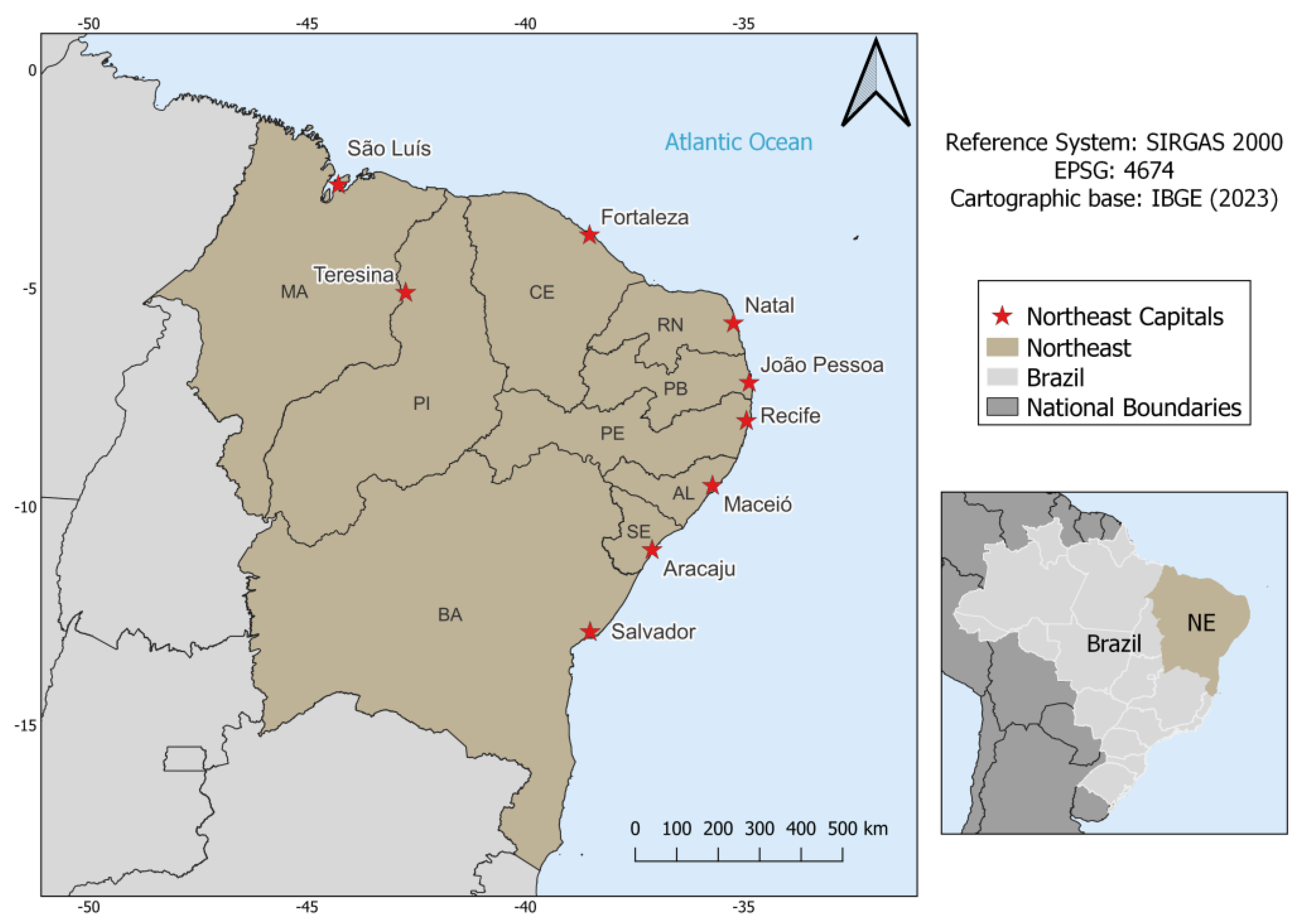
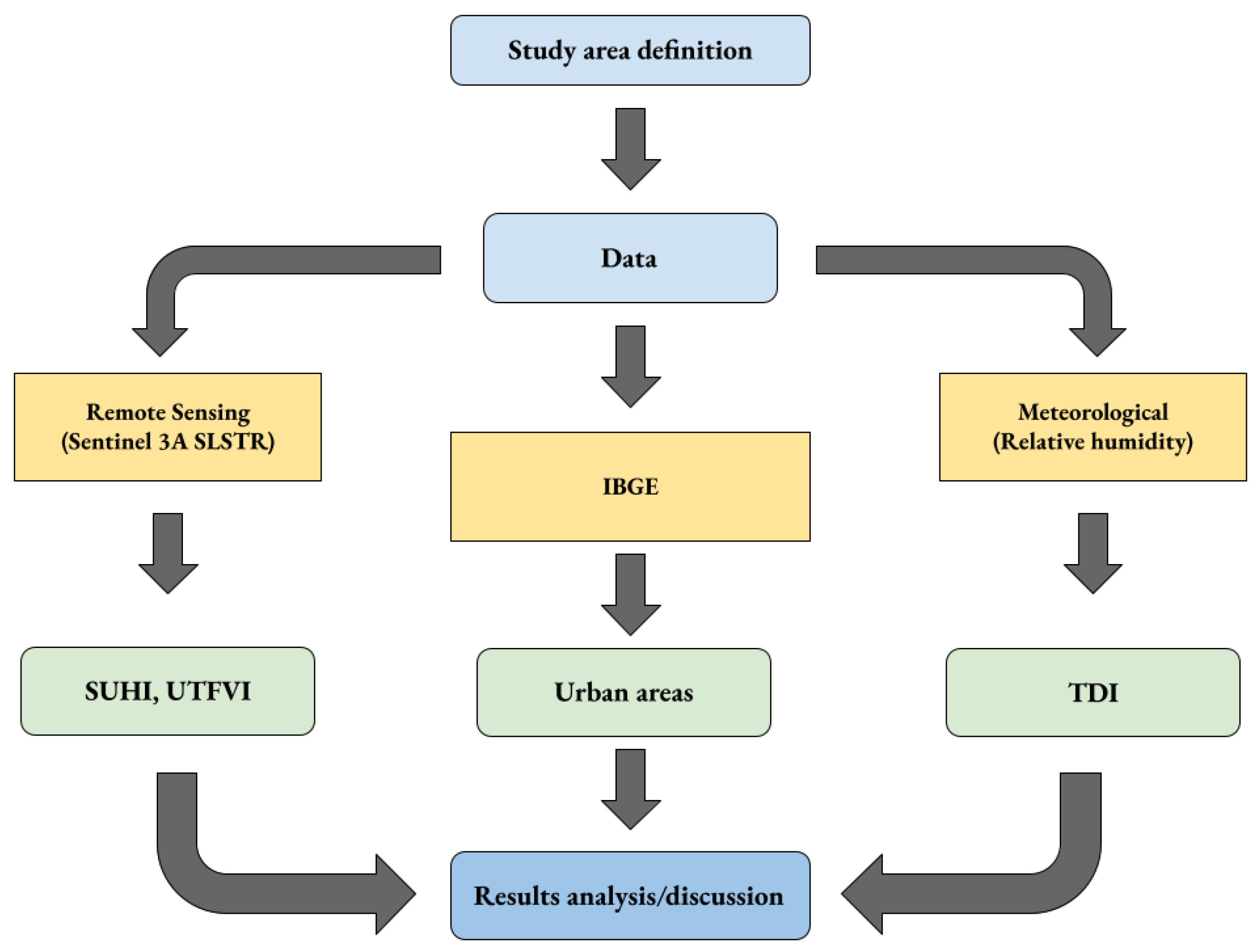
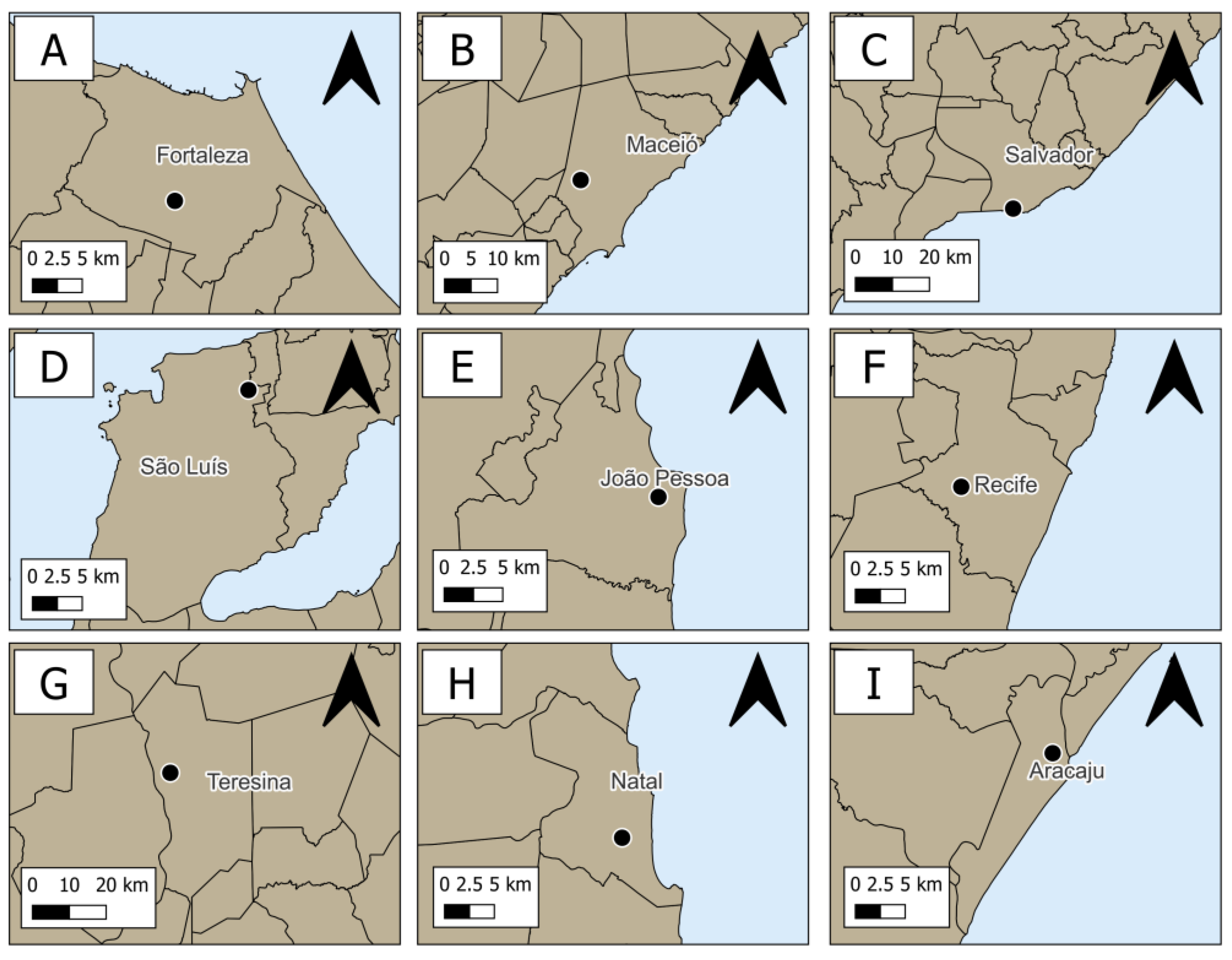
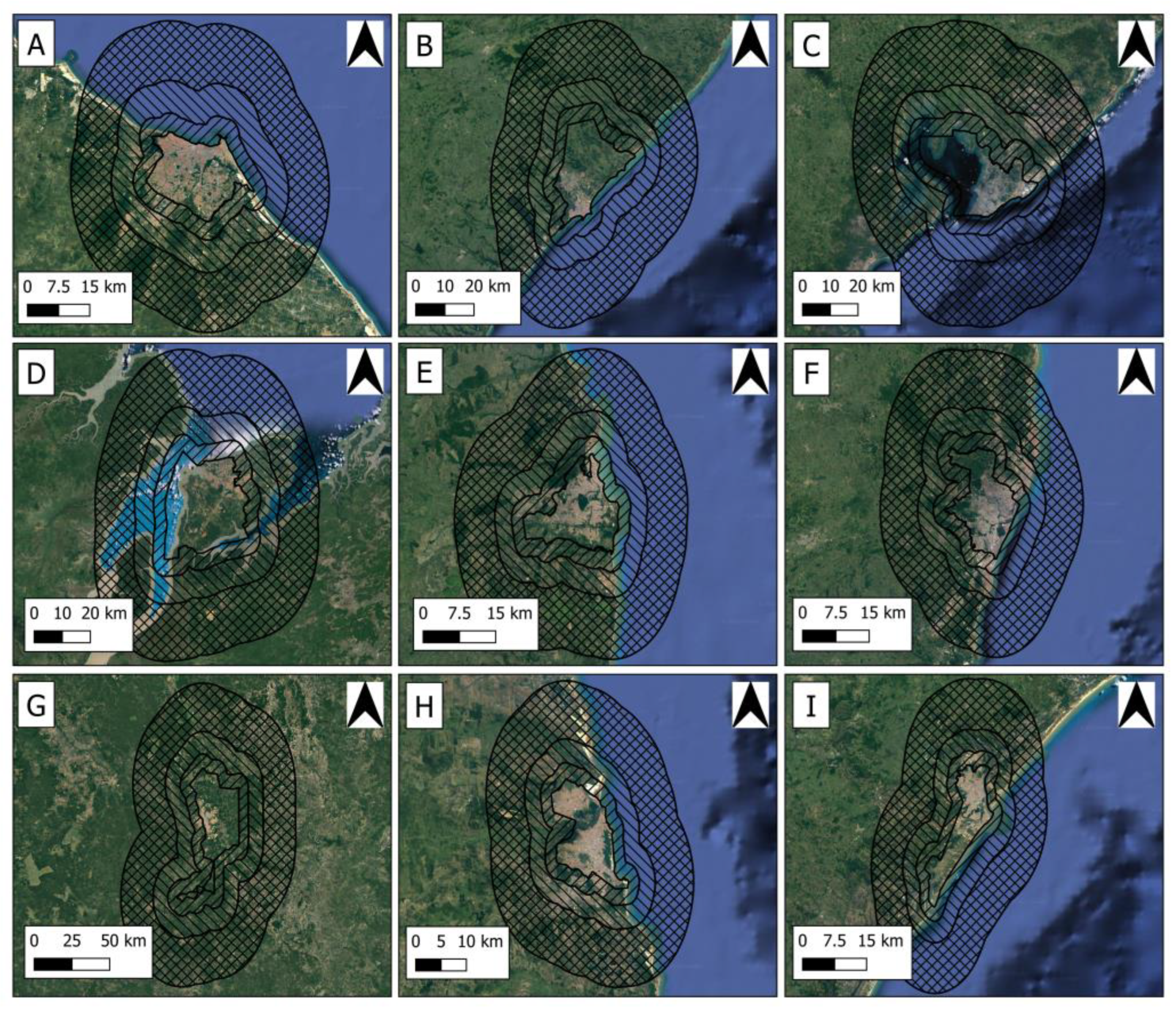
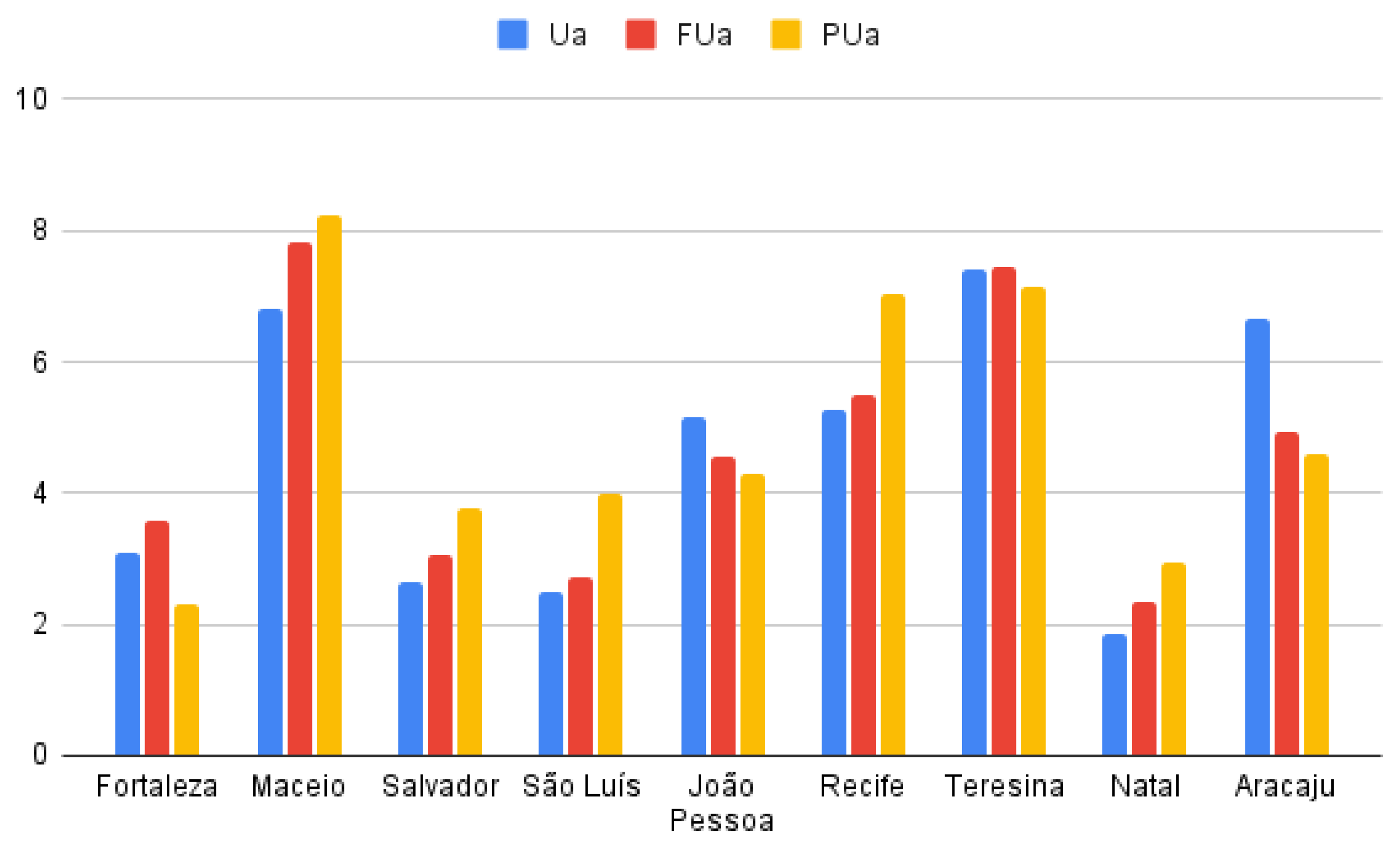
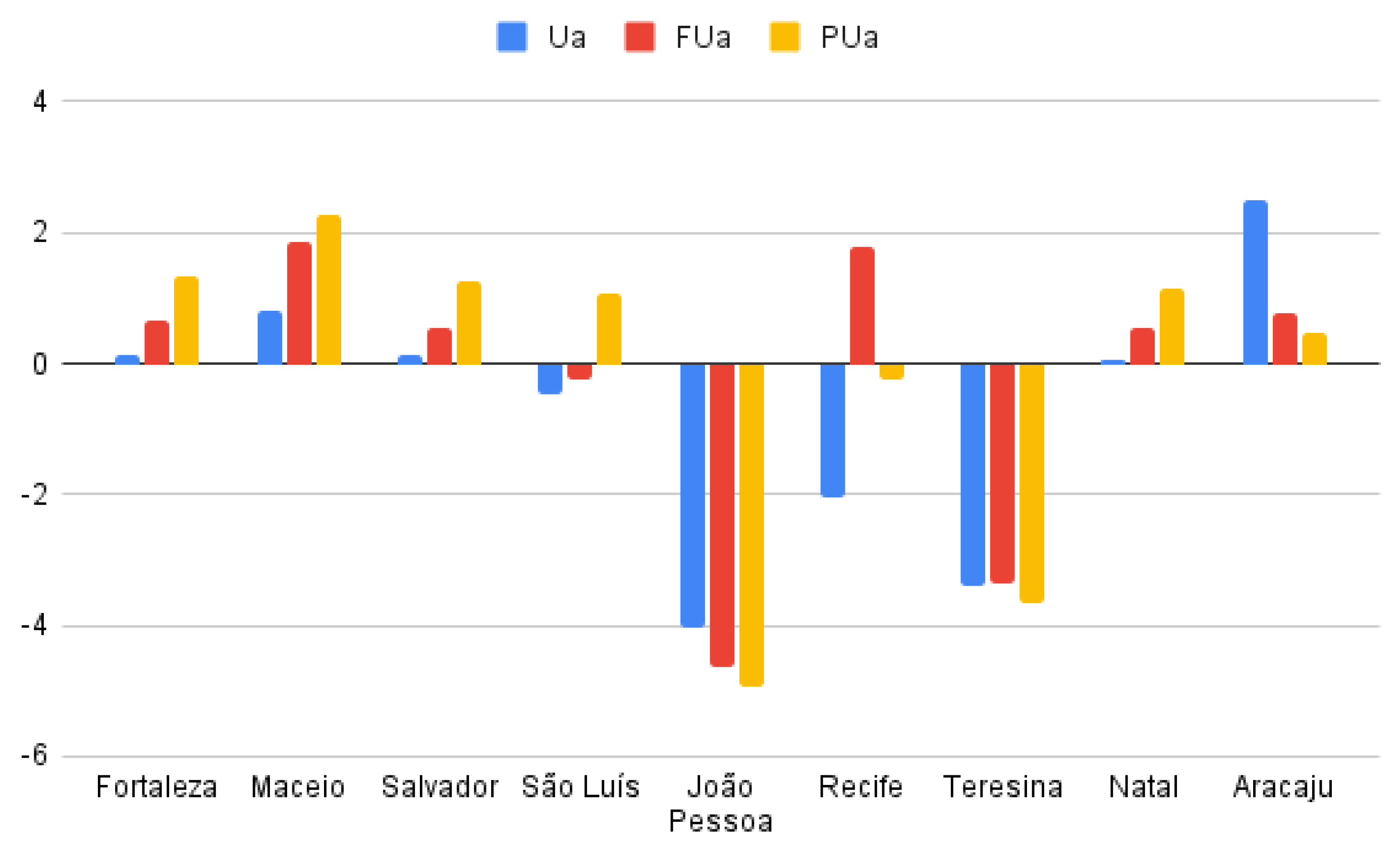
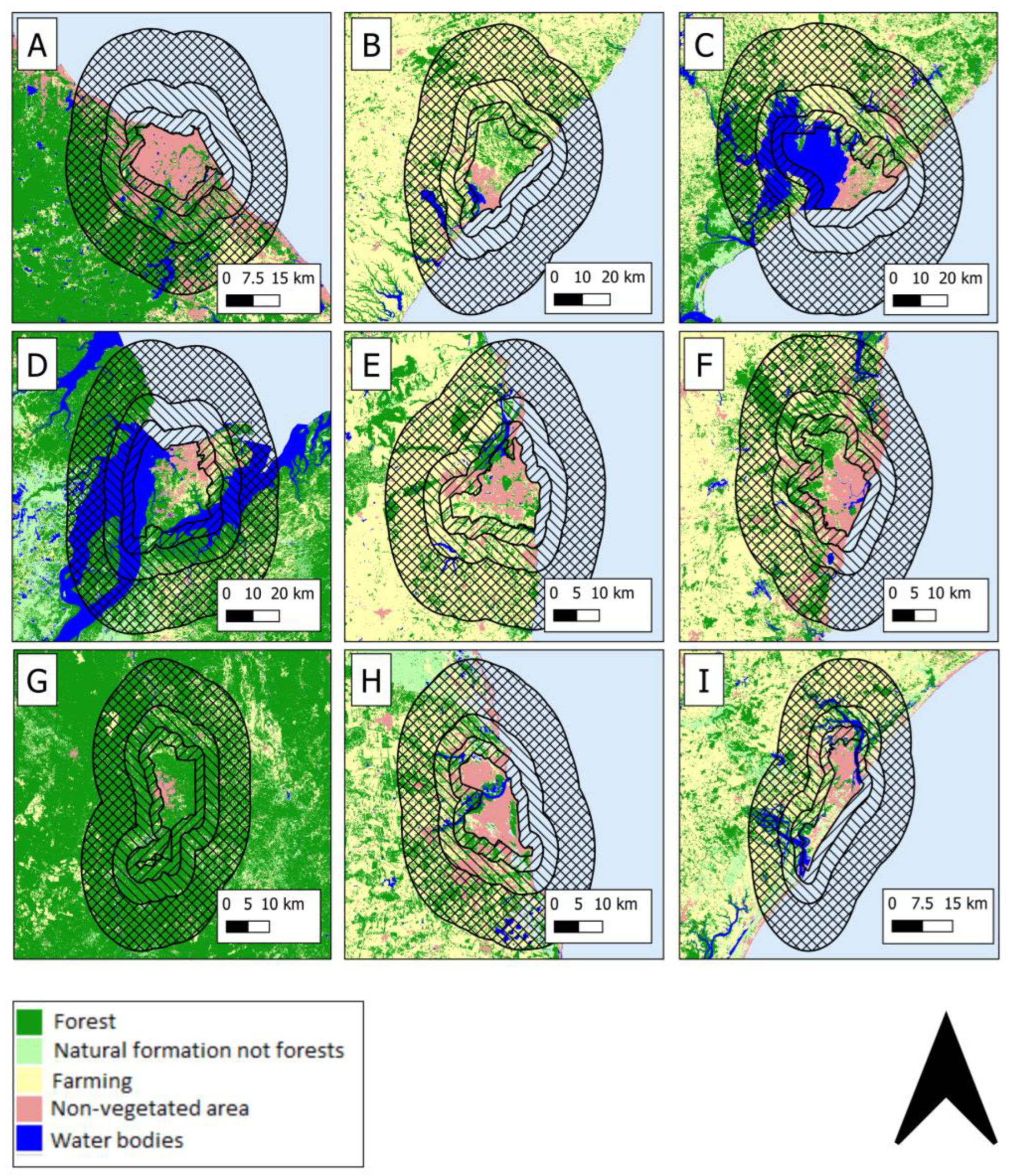
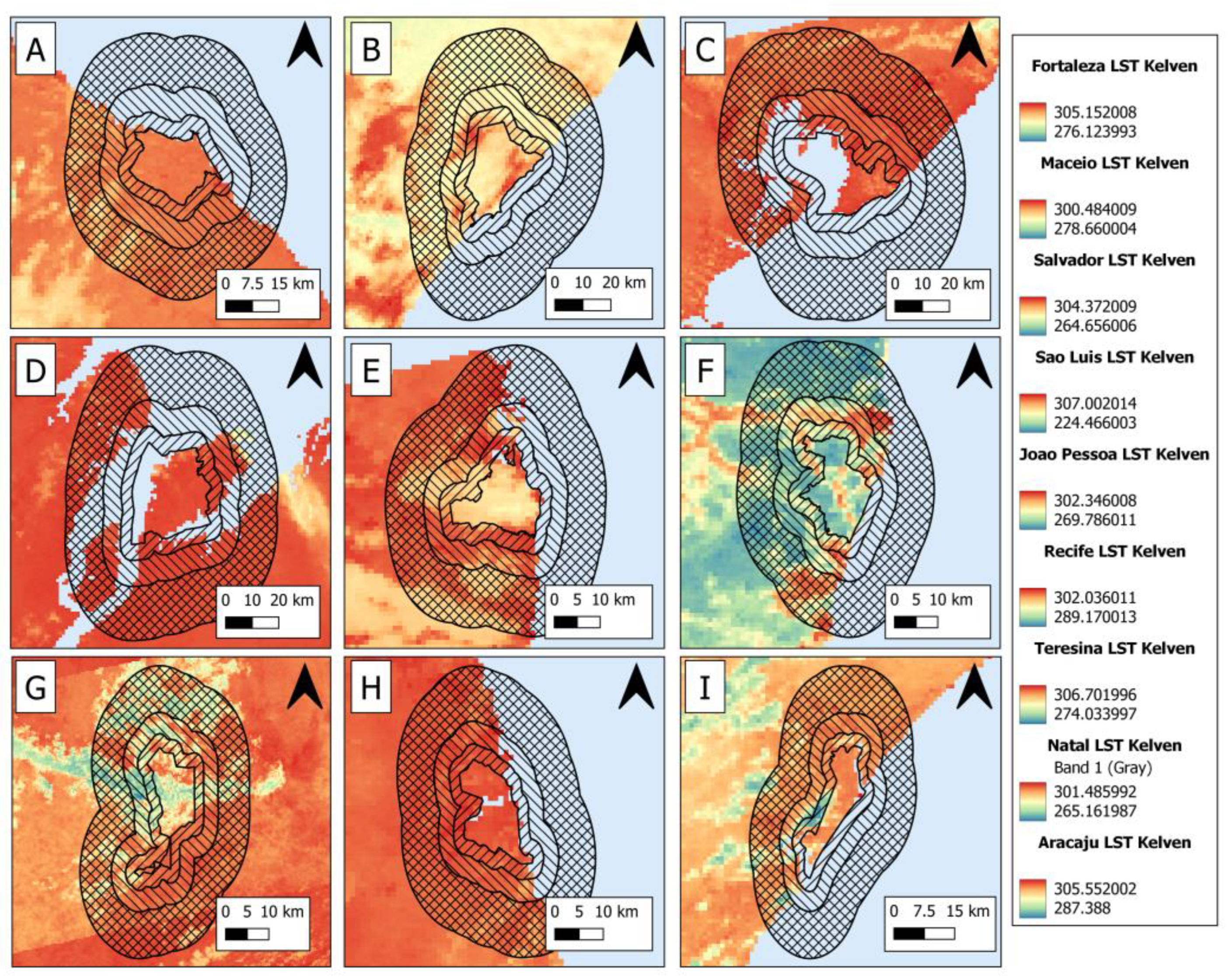
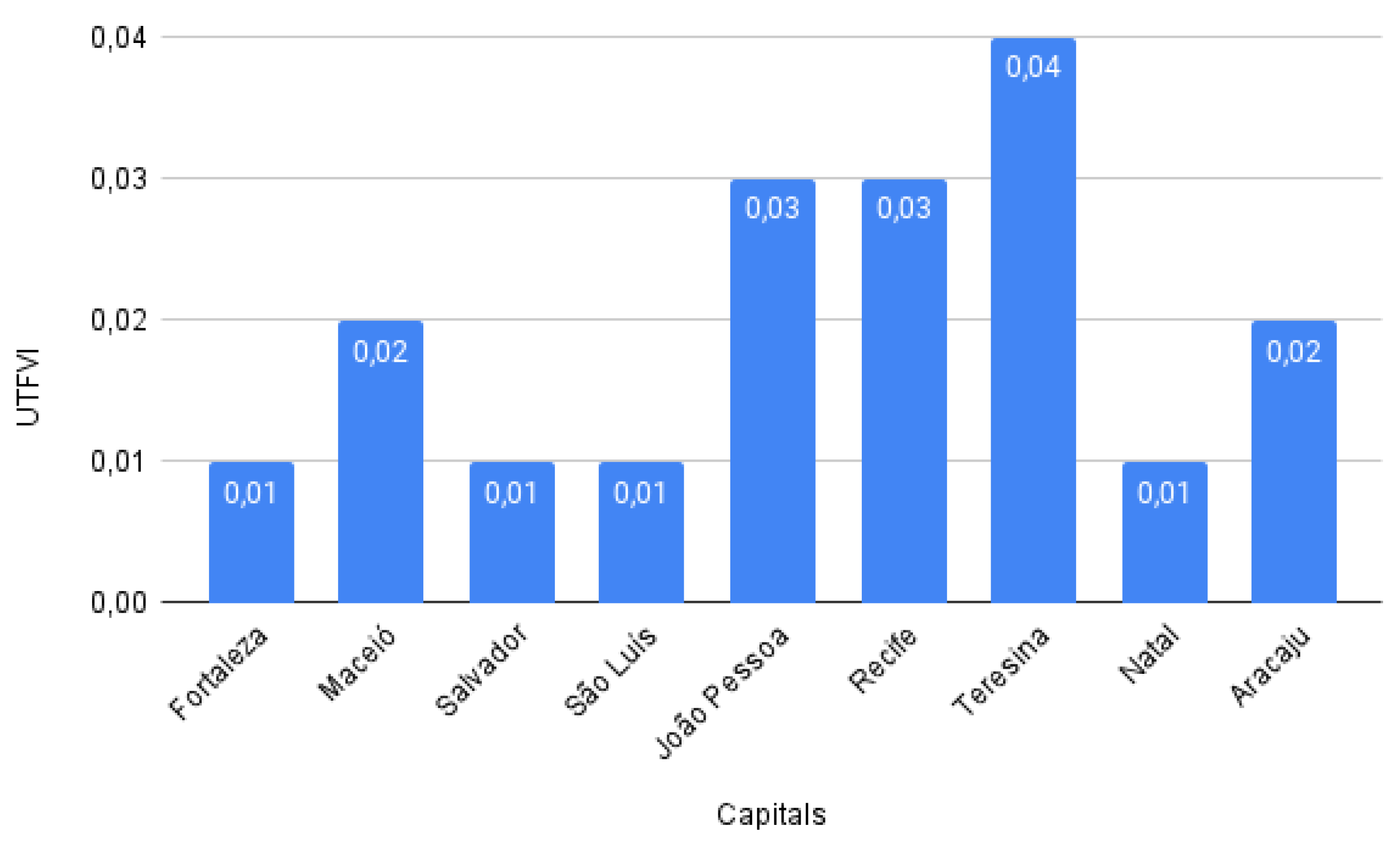
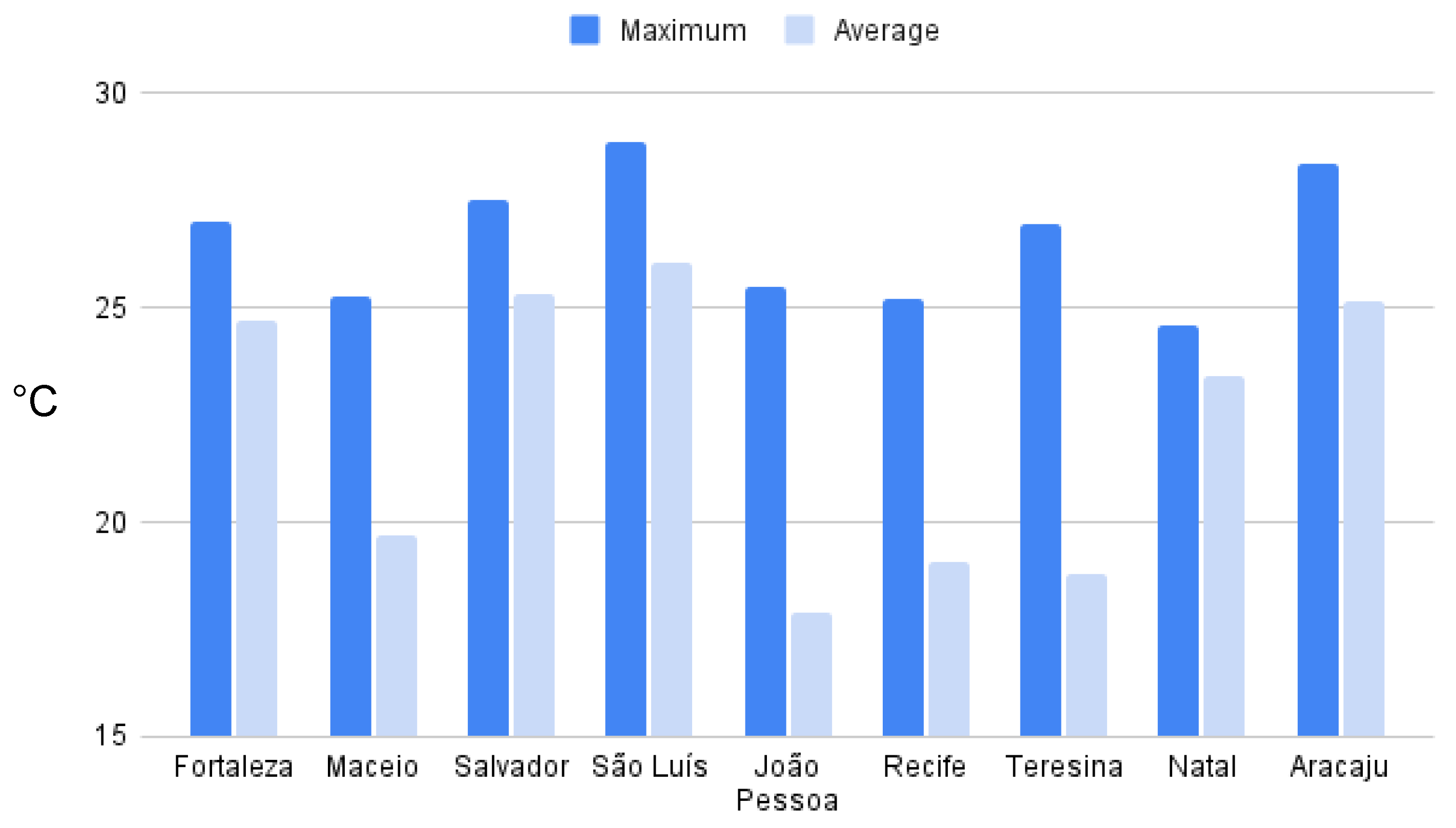
| Capitals | Areas (km²) |
Estimated population | Demographic density (hab/km²) |
|---|---|---|---|
| Fortaleza-CE | 312.353 | 2,686.612 | 8601.204 |
| Maceió-AL | 509.320 | 1,025.360 | 2013.194 |
| Salvador-BA | 693.453 | 2,886.698 | 4162.788 |
| São Luís-MA | 583.063 | 1,108.975 | 1901.981 |
| João Pessoa-PB | 210.044 | 817,511 | 3892.094 |
| Recife-PE | 218.843 | 1,653.461 | 7555.467 |
| Teresina-PI | 1,391.293 | 868,075 | 623.934 |
| Natal-RN | 167.401 | 890,480 | 5319.443 |
| Aracaju-SE | 182.163 | 664,908 | 3650.072 |
| Capital | Data | Hour (GMT) |
| Fortaleza-CE | 14/11/2020 | 00:21 |
| Maceió-AL | 25/02/2020 | 23:00 |
| Salvador-BA | 28/02/2020 | 23:22 |
| São Luís-MA | 29/12/2020 | 00:55 |
| João Pessoa-PB | 28/01/2020 | 23:26 |
| Recife-PE | 28/01/2020 | 23:26 |
| Teresina-PI | 27/11/2019 | 23:33 |
| Natal-RN | 25/02/2020 | 23:00 |
| Aracaju-SE | 28/02/2020 | 23:22 |
| UTFVI | SUHI phenomenon | Ecological evaluation index |
| <0 | None | Excellent |
| 0 – 0.005 | Weak | Good |
| 0.005 – 0.010 | Meddle | Normal |
| 0.010 – 0.015 | Strong | Bad |
| 0.015 – 0.020 | Stronger | Worse |
| >0.020 | Strongest | Worst |
| TDI categories | Temperature (ºC) |
| Hyper Glacial | <-40 |
| Glacial | -39.9– -20 |
| Extremely cold | -19.9– -10 |
| Very Cold | -9.9– -1.8 |
| Cold | -1.7– 12.9 |
| Cold | 13 – 14.9 |
| Comfortable | 15 – 19.9 |
| Hot | 20 – 26.4 |
| Very Hot | 26.4– 29.9 |
| Torrid | >30 |
| City | Average LST | Max SUHI Ua | Max SUHI FUa | Max SUHI PUa | Ave SUHI Ua | Ave SUHI FUa | Ave SUHI PUa | Max UTFVI | Max TDI | Date |
|---|---|---|---|---|---|---|---|---|---|---|
| Fortaleza | 28.39 | 3.10 | 3.57 | 2.31 | 0.13 | 0.67 | 1.35 | 0.01 | 26.99 | 14/11/20 |
| Maceió | 21.13 | 6.79 | 7.83 | 8.25 | 0.82 | 1.86 | 2.28 | 0.02 | 25.24 | 25/02/20 |
| Salvador | 28.18 | 2.66 | 3.07 | 3.77 | 0.14 | 0.55 | 1.25 | 0.01 | 27.50 | 28/02/20 |
| São Luís | 27.71 | 2.48 | 2.71 | 4.00 | -0.46 | -0.23 | 1.06 | 0.01 | 28.89 | 29/12/20 |
| João Pessoa | 19.62 | 5.15 | 4.55 | 4.28 | -4.05 | -4.65 | -4.92 | 0.03 | 25.52 | 28/01/20 |
| Recife | 20.89 | 5.28 | 5.51 | 7.05 | -2.03 | 1.80 | -0.26 | 0.03 | 25.23 | 28/01/20 |
| Teresina | 21.26 | 7.39 | 7.43 | 7.14 | -3.40 | -3.36 | -3.65 | 0.04 | 26.94 | 27/11/19 |
| Natal | 25.82 | 1.85 | 2.33 | 2.94 | 0.06 | 0.54 | 1.15 | 0.01 | 24.61 | 25/02/20 |
| Aracaju | 29.25 | 6.65 | 4.92 | 4.61 | 2.50 | 0.77 | 0.46 | 0.02 | 28.37 | 28/02/20 |
Disclaimer/Publisher’s Note: The statements, opinions and data contained in all publications are solely those of the individual author(s) and contributor(s) and not of MDPI and/or the editor(s). MDPI and/or the editor(s) disclaim responsibility for any injury to people or property resulting from any ideas, methods, instructions or products referred to in the content. |
© 2023 by the authors. Licensee MDPI, Basel, Switzerland. This article is an open access article distributed under the terms and conditions of the Creative Commons Attribution (CC BY) license (http://creativecommons.org/licenses/by/4.0/).





